Phytochemical screening is essential to determine the potential pharmacological activity of the plant or even microorganisms.
- Characterization and evaluation of phytoconstituents can help in the exploration of therapeutic claims of those plants against various ailments.
- High-throughput techniques such as Liquid Chromatography (LC), High-Performance Liquid Chromatography (HPLC), Gas Chromatography (GC), etc., can precisely identify the phytoconstituent both quantitatively and qualitatively. However, these techniques are quite costly and cannot be readily available.
- Conventional phytochemical tests are easier, more economical, and require fewer resources for preliminary phytochemical screening.
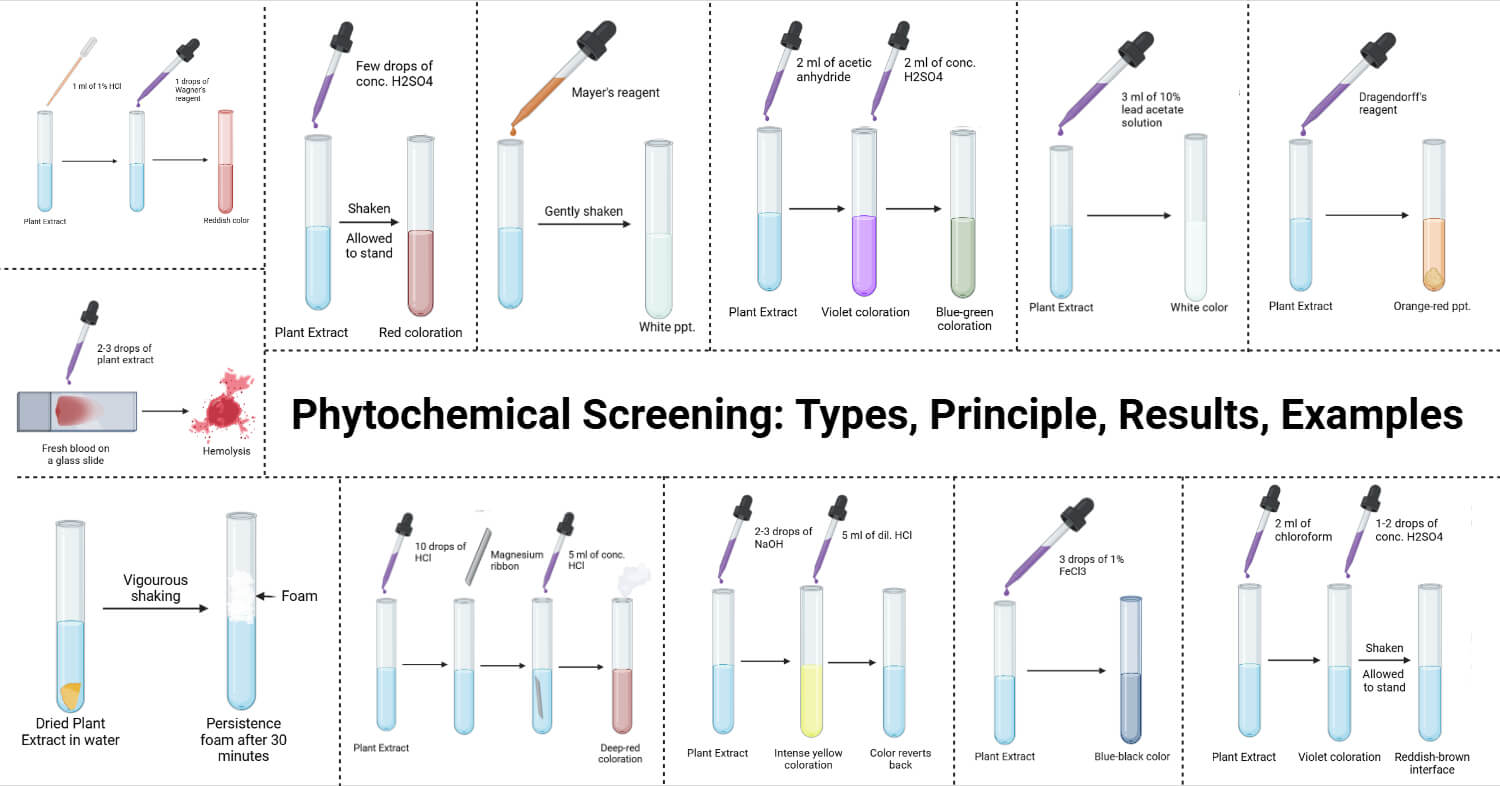
Requirements for Phytochemical Screening
Apparatus required
- Glassware (10 ml test tube, measuring cylinder)
- Micropipette and tips
- Sterile Dropper
Chemicals required
- Dilute hydrochloric acid (HCl)
- Potassium Iodide (PI)
- Iodine
- Dilute and Concentrated Sulphuric acid (H2SO4)
- Lead acetate
- Chloroform
- Sodium hydroxide (NaOH)
- Mercuric chloride
- Ferric chloride
- Sodium bicarbonate
- Magnesium ribbon
- Glacial acetic acid
- Bismuth carbonate
- Picric acid
- Distilled water
| S.N. | Reagents/Solutions | Composition |
| 1. | Mayer’s reagent | A: 1.358 gm mercuric chloride in 50 ml distilled water B: 5 gm of potassium iodide (PI) in 10 ml distilled water Working solution: A + B + distilled water to make a final volume of 100 ml |
| 2. | Dragendroff’s reagent | Stock solution: Boil 5.2 gm of Bismuth carbonate, 4 gm of sodium iodide, and 50 ml of glacial acetic acid for a few minutes. |
| 3. | Wagner’s reagent | 1 gm of iodine and 3 gm of potassium iodide in 50 ml distilled water |
| 4 | Hager’s reagent | 1 gm of picric acid in 100 ml distilled water |
Test for Alkaloids
1. Mayer’s Test
Principle:
Alkaloids consist of a nitrogen atom that forms a coordinate covalent bond with the potassium ion of Mayer’s reagent, which is also known as potassium tetraiodomercurate.
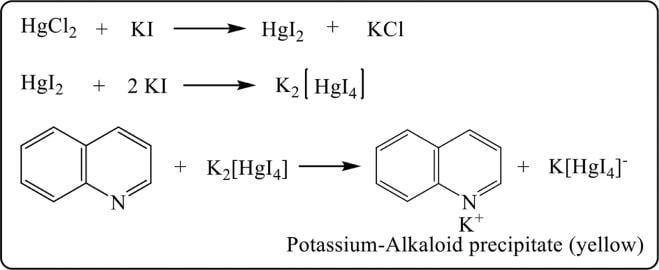
Protocol:
- 1 ml of plant extract was taken in a test tube.
- A few drops of Mayer’s reagent were added to the tube.
- The mixture was shaken gently.
Positive result: The appearance of a cream-colored, yellowish, or white precipitate indicated the presence of alkaloids.

2. Dragendorff’s test
Principle:
Dragendorff’s reagent is prepared by dissolving a concentrated solution of potassium iodide with a solution of bismuth subnitrate in a diluted acid (usually acetic acid), as a low pH is crucial for the reaction. The black precipitate of bismuth iodide is formed from the reaction of bismuth ions and potassium iodide.
Bi3+ + 3 KI → BiI3 + 3 K+
Similarly, the reaction between bismuth ions and excess potassium iodide will produce a more soluble complex of potassium tetraiodobismuthate, which has an orange coloration.
BiI3 + KI → K(BiI4)
Alkaloids have a tertiary amine group.
R3N + HX → [R3NH]+ + X−
(X− = anions of acid)
The potassium tetraiodobismuthate from Dragendorff’s reagent reacts with ammonium salt to produce an orange insoluble complex salt.
[R3NH]+X− + K[BiI4] → [R3NH]+[BiI4]− + KX
Protocol:
- 2 ml of plant extract was taken in a test tube.
- 1 ml of Dragendorff’s reagent was added to the tube.
Positive Result: The appearance of an orange-red precipitate indicated the presence of alkaloids.

3. Wagner’s test
Principle:
Iodine in the Wagner’s reagent reacts with the I– ion from potassium iodide (KI), producing I3- ion (brownish solution). When an alkaloid reacts with a K+ metal ion, it binds covalently with the nitrogen of the alkaloid, producing a complex precipitate of potassium alkaloid.
Protocol:
- 0.5 ml of extract was taken in a test tube.
- It was dissolved in 1 ml of 1% (v/v) HCl.
- 3 drops of Wagner’s reagent were added to the solution.
Positive result: The appearance of a reddish color indicated the presence of basic alkaloids.
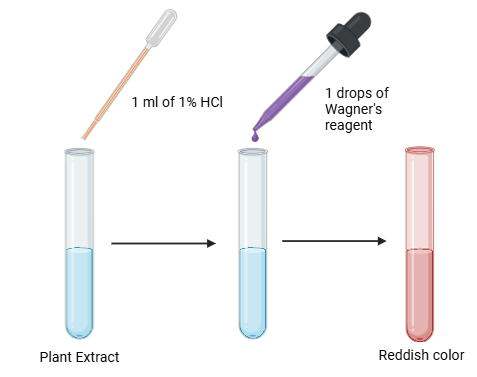
Test for Phenolic compounds
1. Ferric chloride test
Principle:
Phenolic compounds bind with ferric ions, producing an intense color which may vary from blue, green, or even red coloration depending upon the nature of the phenol.
6 PhOH + Fe3+ → [Fe(OPh)6]3– + 6H+
Protocol:
- 1 ml of plant extract was dissolved in 1 ml of sterile distilled water in a test tube.
- 3 drops of 1% (w/w) FeCl3 were added to the solution.
Positive result: The blue-black/violet color indicates the presence of polyphenols and tannins.
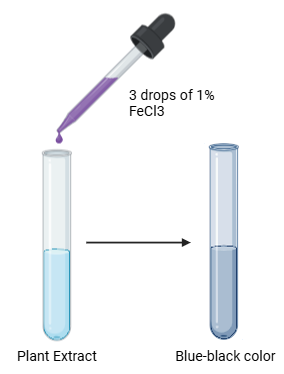
2. Lead acetate test
Protocol:
- The plant extract was taken in a test tube.
- 3 ml of 10% lead acetate solution was added to the mixture.
Positive result: The appearance of a white precipitate indicates the presence of phenolic compounds.

Test for Saponins
1. Foam test
Principle:
Saponins contain polar groups called glycosyl and non-polar groups, steroids, and triterpenoids, which are surface-active compounds. When shaken with water, the polar groups face to the outside and their non-polar counterparts face inside, causing foam.
Protocol:
- 0.5 gm of dried plant extract was dissolved in 2 ml of distilled water in a test tube.
- The mixture was shaken vigorously for 30 seconds in a sterile test tube.
Positive result: The persistence of foam after 30 minutes indicates the presence of saponins.

2. Hemolysis test
Principle:
Saponins have hemolytic properties. They damage the erythrocyte cell membrane by forming insoluble complexes with cholesterol, resulting in a zone of hemolysis.
Protocol:
- A few drops of fresh blood were taken on a glass slide.
- It was mixed with plant extract.
Positive result: The appearance of a zone of hemolysis indicates the presence of saponins.
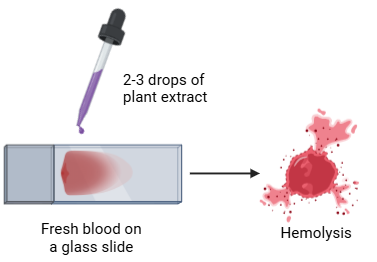
Test for Flavonoids
1. Alkaline reagent test
Principle:
When a flavonoid is treated with NaOH, it reacts with the hydroxide ions, forming a yellow-colored solution. Flavonoids with a free hydroxyl group on the C-2 position form a stable anion in an alkaline condition and become yellow. When HCl is added, the solution becomes acidic, causing the flavonoid to revert to its original form (colorless).
Protocol:
- 2 ml of plant extract was taken in a test tube.
- 2-3 drops of sodium hydroxide (NaOH) were added to the solution.
- 5 ml of dilute HCl was added to the mixture.
Positive result: The appearance of intense yellow coloration that disappears upon the addition of dilute HCl indicates flavonoids.

2. Shinoda’s test/ Mg-hydrochloride reduction test
Principle:
The Shinoda test involves the change of flavones (yellow) into anthocyanidins (orange to deep-red) in the presence of Mg and HCl.
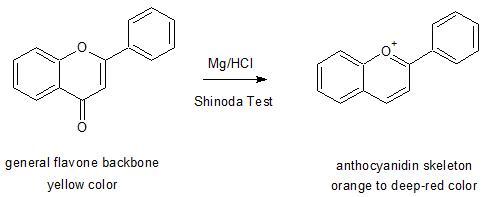
Protocol:
- A few ml of plant extract was taken in a test tube.
- 10 drops of dilute HCl were added to the mixture.
- A magnesium ribbon was added to the mixture.
- It was dissolved by the addition of a few drops of concentrated HCl.
Positive result: The appearance of orange to deep-red coloration indicates the presence of flavonoids (flavanol glycosides).

Test for Phytosterols
1. Salkowski’s Test
Principle:
Salkowski’s test for the determination of phytosterols is based on a dehydration reaction. When sterols are treated with chloroform and highly hygroscopic H2SO4, two water molecules are removed from two cholesterol molecules, resulting in the formation of two double bonds. The sterols bind and form bisterol, and in the case of cholesterol, bi-cholestadien (double cholesterol with two double bonds) is formed. The solution becomes red as a result of the sulfonating bi-cholestadien.
Protocol:
- A few drops of concentrated H2SO4 were added to the plant extract.
- The mixture was shaken well and allowed to stand.
Positive result: The appearance of the red color indicates the presence of phytosterol.

2. Lieberman-Burchard test
Principle:
The Lieberman-Burchard test is used to detect cholesterol. The test involves acetic anhydride and sulfuric acid as reagents, which are responsible for the gradual change of coloration from violet to green in the presence of cholesterol.
Protocol:
- 5 ml of aqueous plant extract was taken in a test tube.
- 2 ml of acetic anhydride and 2 ml of concentrated H2SO4 were added to the tube.
Positive result: The change of coloration from violet to blue/green indicates the presence of phytosterol.

Test for Terpenoids
1. Salkowski’s test
Principle:
Chloroform separates terpenoids from other phytochemicals. Then conc. H2SO4 reacts with the terpenoids to produce a reddish-brown interface.
Protocol:
- 5 ml of plant extract was taken in a test tube.
- It was dissolved in 2 ml of chloroform with 1-2 drops of concentrated H2SO4.
- The mixture was shaken well and allowed to stand.
Positive result: The appearance of a reddish-brown interface indicated the presence of terpenoids.

Table 1: Table of Phytochemicals, their screening tests and positive results.
| Phytochemical | Name of Test | Positive results |
| Alkaloids | Mayer’s test | Creamy white/yellow ppt. |
| Dragendorff’s test | Orange-red | |
| Wagner’s test | Brown/reddish ppt. | |
| Phenolic compounds | Ferric chloride test | Blue/violet |
| Lead acetate test | White ppt. | |
| Saponins | Foam test | Persistence of foam |
| Hemolysis test | Zone of hemolysis | |
| Flavonoids | Alkaline reagent test | Intense yellow coloration, which becomes colorless after the addition of dilute acid |
| Shinoda’s test | Deep-red coloration | |
| Phytosterol | Salkowski’s test | Red coloration |
| Lieberman-Burchard test | Change of coloration from violet to blue-green | |
| Terpenoids | Salkowski’s test | Reddish-brown interface |
Precautions during Phytochemical Screening
- Preliminary tests are qualitative and only give little information on whether the compound is present; more robust quantitative techniques should be performed for confirmation.
- It is important to consider the extraction solvent of the phytochemicals, because incompatible solvents may give false negative results.
- Hands should be well-washed after using reagents such as Mayer’s reagent.
- Dragendorff’s reagent is sensitive to light and should be stored in the dark.
- Ferric chloride is corrosive and should be handled with care.
- Lead acetate is a heavy metal compound and should be discarded with care.
- The foam of saponins should persist for about 30 minutes after vigorous shaking.
- In Shinoda’s test, the reaction between concentrated H2SO4 and Mg ribbon is exothermic and can produce fumes which should be handled with care.
- Strong acids should be handled properly.
- Proper Personal Protective Equipment (PPE) should be worn during the experiment.
- The area where the test is performed should be well ventilated.
References
- Alkaloids-Introduction, 6 chemical tests, classification, health benefits—Chemistry Notes. (n.d.-b). Retrieved March 27, 2025, from https://chemistnotes.com/natural/alkaloids-introduction-chemical-test/
- Dubale, S., Kebebe, D., Zeynudin, A., Abdissa, N., & Suleman, S. (2023). Phytochemical Screening and Antimicrobial Activity Evaluation of Selected Medicinal Plants in Ethiopia. Journal of Experimental Pharmacology, 15, 51–62. https://doi.org/10.2147/JEP.S379805
- How does Salkowski’s Test for Steroid content work? (2019, February 28). ResearchGate. https://www.researchgate.net/post/How-does-Salkowskis-Test-for-Steroid-content-work
- Shaikh, J. R., & Patil, M. (2020). Qualitative tests for preliminary phytochemical screening: An overview. International Journal of Chemical Studies, 8(2), 603–608. https://doi.org/10.22271/chemi.2020.v8.i2i.8834
- Sharma, T., Pandey, B., Shrestha, B. K., Koju, G. M., Thusa, R., & Karki, N. (2020). Phytochemical screening of medicinal plants and study of the effect of phytoconstituents in seed germination. Tribhuvan University Journal, 35(2), 1-11.
- Team, E. (2022, March 30). Mayer’s Test for alkaloids – Procedure, Mechanism, Results, Uses – Laboratoryinfo.com. https://laboratoryinfo.com/mayers-test-for-alkaloids-procedure/
- Zohra, S. F., Meriem, B., & Samira, S. (2012). Phytochemical Screening and identification of some compounds from Mallow.
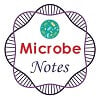
Great work. Keep it up.
Looking forward to future engagements God’s wiling.